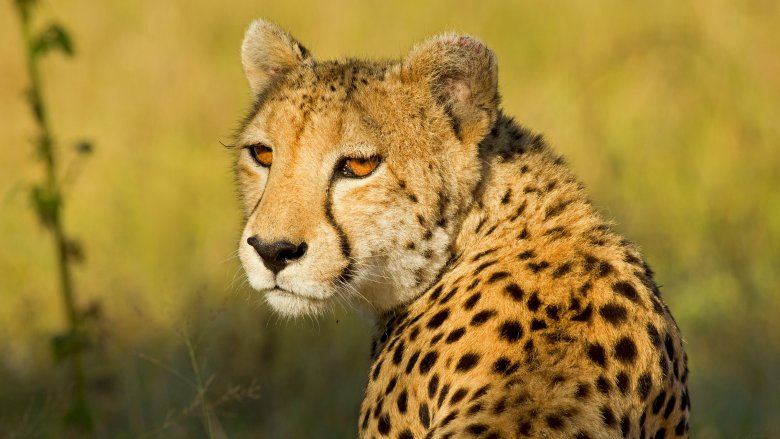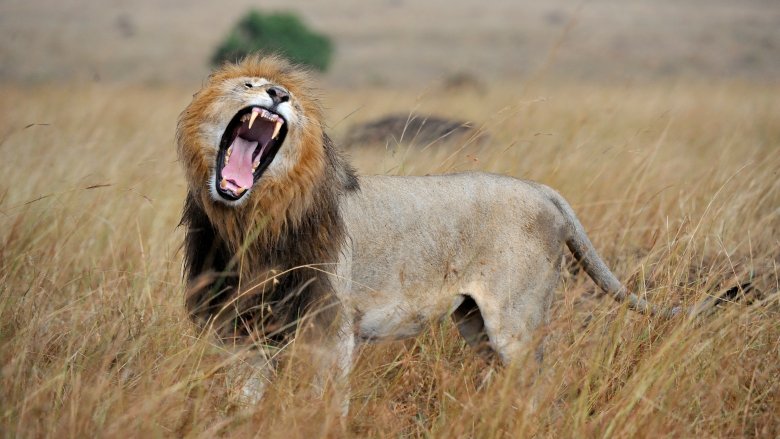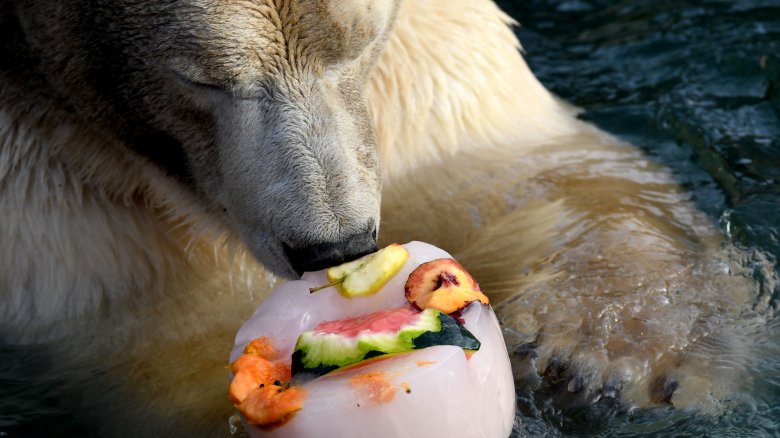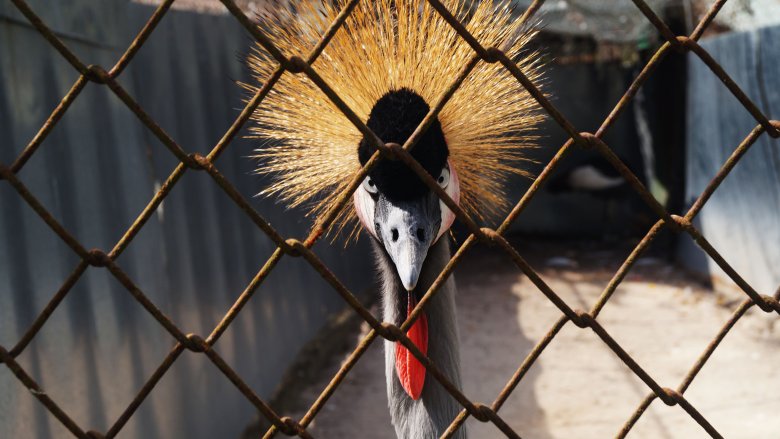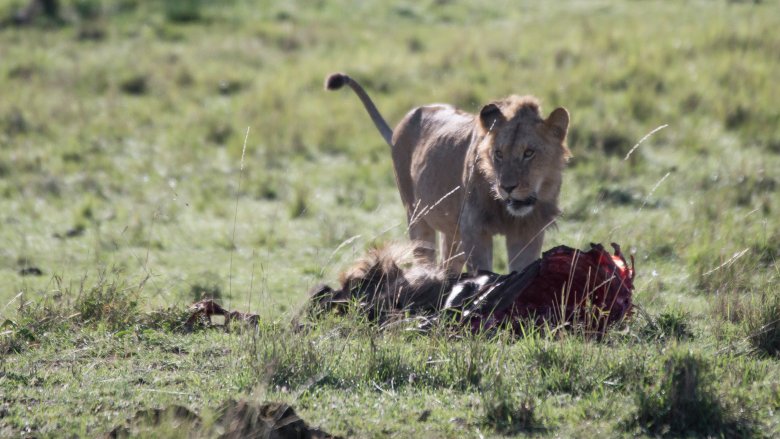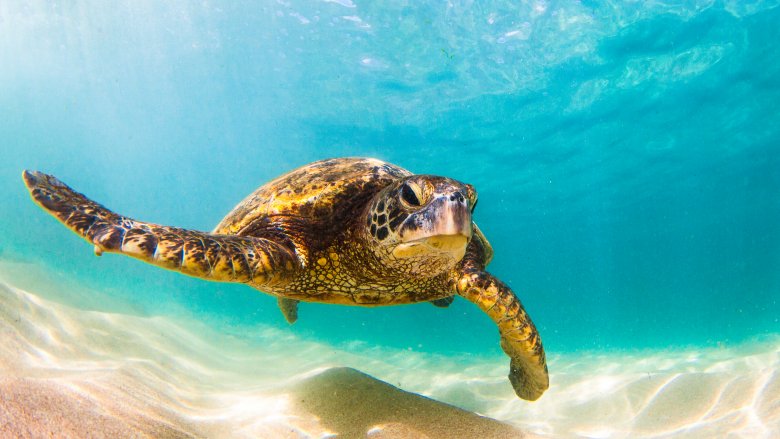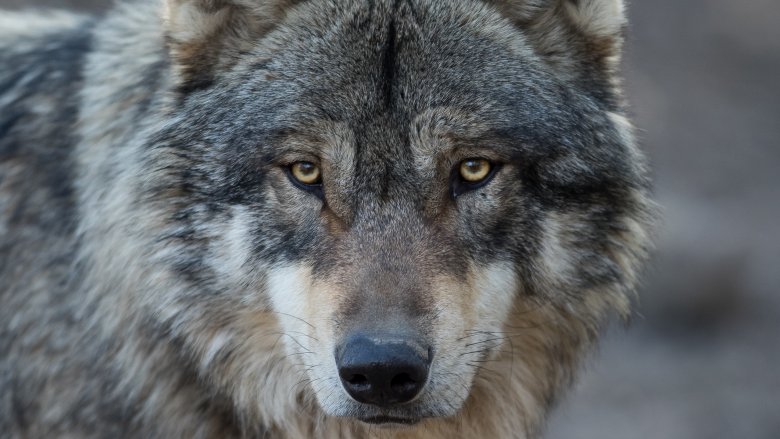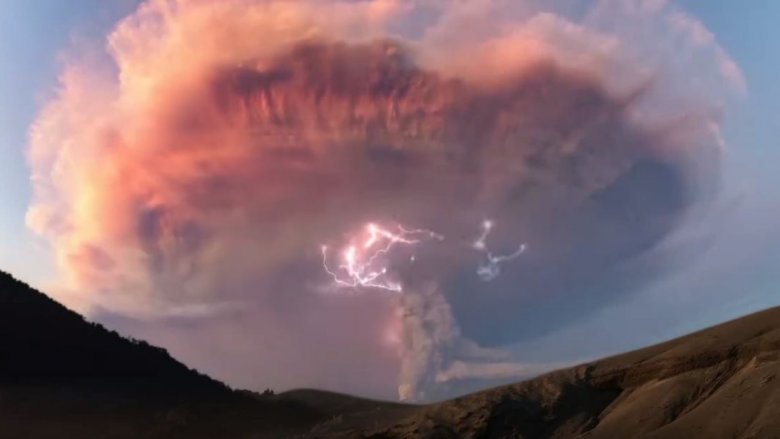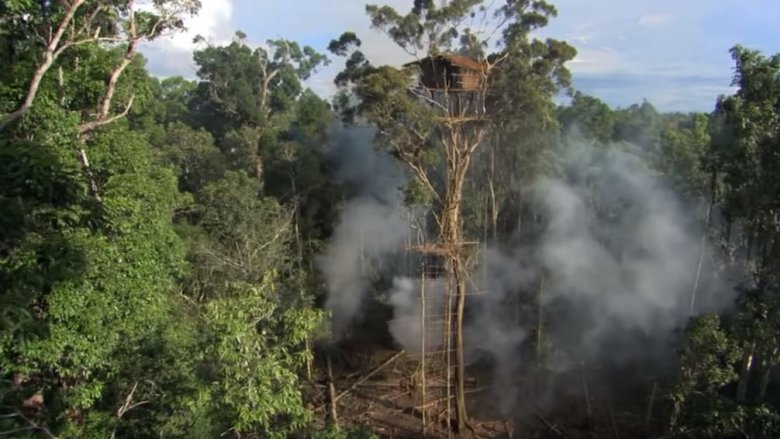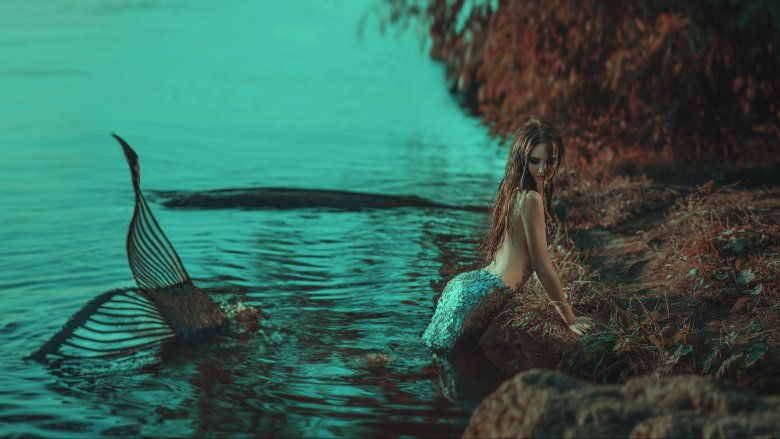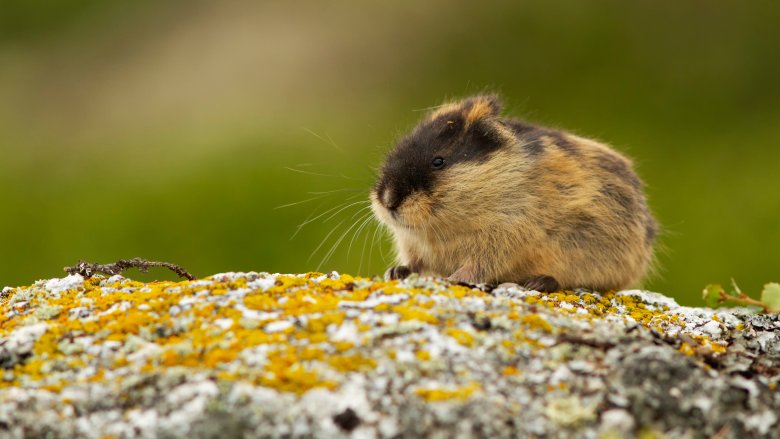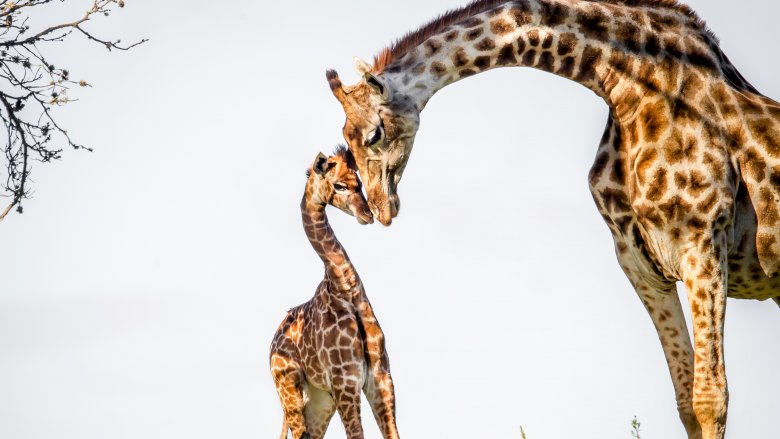All The Ways Nature Programming Lies To You
On those lazy sick days where you just want to passively binge watch something easy but entertaining, there would seem to be nothing more innocuous than a nature documentary featuring cute penguins, deer, or even the saga of a tight-knit wolf pack. If you watched for long enough, you might be surprised by how engrossing the storylines are, how interesting the wildlife "characters" can be, or how scary a shark's mouth really is when it rushes at the screen. Pretty amazing that you can just stick a camera in the woods and capture such great footage, huh?
Well, it doesn't quite work that way. In order to craft meaningful stories, the average nature program has to resort to trickery and subterfuge, both in the editing room and during the shoot itself. Even worse, certain nature productions have taken some pretty unethical approaches to the whole shebang, and we aren't just talking about knockoff low-budget nature documentaries. This includes all the big names in nature programming.
The sound effects are added later
If you've ever had a grizzly bear stumble into your yard and dump out your recycling and you desperately tried to film the momentous event on your little Android phone, you know what a pain in the neck background noise is, whether it's your Darth Vader breathing or the wind gusts that just came out of nowhere. Somehow, though, nature programs don't seem to have this problem. Have you ever wondered why? Even though the camera perfectly captures every microscopic speck of blood on that lion's teeth, the sound of the animal's roar is crystal clear. Listen to the alligator splashing! Hear the deer's hooves perfectly crunching through fresh snow! The snake hisses, the birds chirp, goats lock horns, and...
...sorry, but it's all added in post. As explained by Vox, all that stunning footage of giraffes, hippos, buffalo, and so on is filmed from very far away, and while cameras can zoom in close, microphones don't do that. Seriously, would you want to stick some contraption right up to a Komodo dragon's mouth? Didn't think so.
According to 99 Percent Invisible, all those subtle and pleasing nature sounds, like a turtle sifting through sand, are made by professionals called Foley artists, whose jobs are literally moving around in little sound studios to create sounds such as splashing, tapping wood, pushing around branches, or whatever else is necessary. Admittedly, it's probably a fun job. Vocalizations like a howling monkey, on the other hand, are pulled from stock audio libraries. Some things have sounds added for viewers' sakes, though. Elephants, for example, have very soft almost inaudible footfalls. But it would be weird to see such a heavy animal walking quietly, so Foley artists add in some thuds.
Trick or treat? How about both
Try taking a selfie with your Dalmatian, Sir Spotty Barksalot, and see if he stays still for three seconds (without you telling him to, you cheater). No? Well, most animals don't care about posing for the camera, which presents a big problem for nature filmmakers who want to capture cool shots, instead of giving you two hours of a moose traipsing through the woods looking for a good place to pee. As a result, filmmakers have often resorted to various tricks and treats to get animals to do interesting things for the camera, while the edited film later pretends it's all spontaneous. The Independent describes how candies have been employed as a tool to lure in bears, and how a fake seal was used as shark bait.
Understandable? Sure. But is it ethical? After all, these animals are just trying to mind their business, not do circus stunts. Besides that, these tricks and treats can sometimes cause real problems, as the Huffington Post explains: for instance, a shark that's baited with an unachievable meal for long enough might eventually give up on eating for the day.
Filmed in a zoo
Wildlife documentaries are generally filmed far away from the animals — as they certainly should be — but this sometimes makes it difficult to get those nice close-ups shots. One of the easiest solutions for this, according to the Independent, is to bring your crew into the local zoo, nature park, or research center, and roll the cameras. This makes it a lot less tedious to capture things like fish eggs hatching, and as the BBC points out, it's definitely way easier to film the inside of a captive ant nest without touching or harming the little guys than it would be to try sneaking a camera inside a wild one.
Call it cheating or call it clever, but this stuff happens. When viewers find out, though, they aren't usually too happy. In 2011, the Independent reported that BBC viewers were a bit peeved to learn that a sequence of a mother polar bear caring for her newborn cubs, featured in Sir David Attenborough's Frozen Planet, had been filmed in a man-made den in a Dutch zoo and then presented as if the bears were in the wild. While the network did clarify this on their website, the actual program didn't, and many viewers felt misled. In response to the controversy, Attenborough said the zoo footage was used mostly for safety reasons to avoid any potential dangers that could have befallen a wild polar bear mama, her cubs, or the camera crew. Okay, fine, but still tell the viewers.
Don't buy the storylines
The best nature programs usually have storylines worthy of Game of Thrones. Whether it's brothers-turned-enemies showing down for a leadership position, villains preying on the weak, or a mother losing her newborn calf, it's grisly stuff.
As you've probably noticed in your own day-to-day existence, real life isn't usually so epic, whether you're a human being or a Venus flytrap. As the Independent explains, all those edgy storylines in nature programs have less to do with the animals themselves and more to do with creative cutting that goes down in the editing room. Just a few decades ago, back in the 1990s and before, the Huffington Post points out that these storylines were created in a crueler fashion. For example, rabbits would have their legs snapped for the sake of a predator-prey shot, a leopard was set loose on unsuspecting baboons to create a plot twist, and Wild America once intentionally sacrificed a deer to a wolf pack in an enclosed space to create interesting scenes. As unfair as this is to the "prey" animals that were killed or injured for these documentaries, it's also unfair to the "predators," as such sequences create a public misconception of them as being bloodthirsty, merciless monsters a la Ramsay Bolton, rather than just hungry animals who are part of a natural ecosystem.
When in doubt, throw some CGI at it
Nature programming wants to tell a story to entertain viewers, and sometimes you can't get the scenes you want to happen naturally. Hey, that's fair enough. Forcing innocent animals to perform tricks is becoming more widely recognized as cruel, so in recent years, filmmakers have resorted to the same technique that blockbuster movies throw at every alien invasion: computer magic. One film that did this, according to the New York Times, was Turtle: The Incredible Journey, and to be fair, the film openly admitted to using CGI in certain scenes (in the end credits, which no one ever watches). Other nature programs might do things like remove undesired airplane pollution from the sky of a beautiful nature shot because nothing makes a would-be inspirational nature movie more depressing than the reminder that humankind is ruining the planet.
Digital graphics are certainly a new addition to the nature documentary scene, but according to the BBC, certain older movies used approaches like blue screen — the precursor to today's green screen — wherein people, plants, or animals are filmed in a controlled environment with a matte-colored background that is then replaced with a more natural-looking one in post. None of this is super common, but that doesn't mean it didn't happen.
Can't find a real-life predator? No problem
Nature programming tends to thrive on the whole predator/prey archetype, for the same reason George R.R. Martin kills off all your favorite characters. Sometimes, though, there are just no wild carnivores to be found. This presents a particular problem with wolves, according to 99 Percent Invisible, since those beautiful wild canines are absolutely not cool with people — or cameras — being anywhere near them. To deal with this, the production crew for the 1999 IMAX film Wolves decided to "rent" domesticated wolves, put cameras inside a man-made den, and let 'em do their thing. This led to some awesome shots, and producer Chris Palmer was honest about the filming technique with anyone he talked to, but evidently, the test audience wasn't so psyched about it.
That's far from the only time that wolf action has played differently on a screen than in real life, however. The Telegraph reported in 2015 that a BBC program was in hot water when, after failing to find any actual wolves to film, they instead let loose a semi-domesticated one. On camera, the program showed two camel herders seemingly firing shots at the wolf as it hunted their animals from afar, but in reality, the friendly canine was just running to its handler, who was (of course) conveniently located off-camera.
That's a mighty fine volcano explosion...
It's really too bad that killer volcano explosion is fake.
If you were one of the viewers who marveled at that unbelievably gorgeous volcano explosion in the BBC Two program Patagonia: Earth's Secret Paradise, which showed lightning rippling through the smoke (pictured above, in all its fakery), here comes Gizmodo to spoil the illusion. No, the explosion wasn't totally made of CGI or anything quite so infuriating, but it did involve some detailed camera trickery: basically, they just used some long-exposure footage from one volcano boom, spliced it right onto time-lapse photography from another volcano bust, and voila: a perfect shot to perfectly illustrate a phenomenon (called a "dirty thunderstorm," if you were wondering) which is insanely difficult to legitimately capture on film.
While the result was certainly worthy of an art museum, not everyone was so happy to find out that they'd been "duped." Like a stern older brother, the BBC later lectured BBC Two for not being clear with viewers that the footage was doctored.
Made-for-TV treehouses
All this fakery isn't reserved just for plant or animal programs: Sometimes, nature "documentaries" about human beings resort to the same tricks. The problem, of course, is that unlike animals, people eventually talk about what really happened. For a particularly notorious example of this, check out the way that the BBC Two's 2011 Human Planet series totally misrepresented the Korowai people of Papua New Guinea, according to Gizmodo. While the original program featured a sequence of the Korowai locals building brand new treehouses to serve as their homes, with one (dubbed) tribesman even remarking on his pleasure at the new location, a Korowai man later revealed that the whole thing was staged, describing the treehouses as having only been built "for the benefit of overseas programme-makers."
Basically, the production crew had the Korowai build treehouses that were convenient for their cameras as opposed to being easy for the Korowai people. When the BBC found out about the 2011 crew's manipulations, years after the fact, they apologized for the breach of ethical standards.
The mockumentaries. Oh, the mockumentaries.
While nature programming can be tricky, as you've seen, you can usually count on it to at least present something based on real wildlife, situations, or natural phenomena, even if it's highly manipulated for dramatic effect. However, in recent years, the credibility of the TV landscape has been cracked open a variety of completely fake "mockumentaries," played entirely seriously, but featuring wacky stuff like mermaids, Bigfoot, or Megalodon.
Now, sure, someone could make one of these just for giggles. A mockumentary can be a clever way to satirize documentaries as a whole, to point out how manipulated the art form is or some other critique, but that's definitely not what stuff like that fake mermaid program was doing: That stuff is just pure greedy capitalism attempting to trick viewers into watching something they hope might be real, only to pull the rug out from underneath them at the last minute (or just lie altogether). As Slate points out, the repercussions of this sort of reality-bending stuff can be surprisingly serious for society as a whole. Because these mockumentaries have aired on seemingly legit networks like Discovery, Animal Planet, and the History Channel with content that doesn't contain any obvious jokes or satire, it leaves a non-discerning channel surfer vulnerable to thinking it's genuine and then believing in something fake, thereby damaging the credibility of science, fact-based institutions, and just of reality in general. Thankfully, enough people worked up enough anger that in 2015 Discovery announced it would no longer be airing mockumentaries, according to Deadline.
Blame Disney for that lemming suicide myth
The blame for what is perhaps the most egregious lie ever told in nature programming to date falls squarely at the feet of good ol' Disney. See, back in 1958, the Mouse House's Academy Award-winning documentary White Wilderness featured an unforgettable scene in which a gang of lemmings all pitched their little bodies off the side of a cliff, hurtled into the Arctic Ocean, and seemingly committed mass suicide. Man, lemmings sure are crazy, huh? Haha. It's no wonder that this bizarre behavior has become the quality that defines lemmings in popular culture, to the point where any foolish person who joins a doomed mass movement might still be referred to as a lemming.
There's just one problem: Lemmings don't jump off cliffs.
As Snopes explains, Disney staged the whole scene. First, they imported lemmings because there weren't any real ones at the filming location. Then they used careful camera angles and also sometimes a turntable to make a few dozen lemmings look like a swarm. Finally, the filmmakers chased the poor animals off the cliff. So not only did the production crew destroy the reputation of these small furry animals for years to come, but they were also guilty of some nasty animal abuse.
On the other hand...
If there's one thing that all this debunking makes clear, it's that nature documentaries aren't quite the perfect encapsulation of the outside world that you might have thought they were. To be fair, though, if some of these editing tricks weren't used, nature programming would be like watching paint dry. As Vox points out, it's the art of storytelling that engages the human mind, not a bulletpoint list of facts, and these stories are created in the editing room. Furthermore, according to the Verge, the idea that documentaries have to present something that's 100 percent accurate is a fairly recent phenomenon: Most early documentaries were widely known to feature staged scenes. On a deeper level, the truth is that creative license is necessary to make a film, well ... a film. Every narrative, no matter how hard it strives for accuracy, has to leave some things out or embellish others in order to tell a story.
Nonetheless, there should be some ground rules that every nature program must follow. For one: No cruelty whatsoever. That's an absolute. Animals shouldn't be forced to perform tricks for the camera, and obviously shouldn't be injured. And two, how about not being actively misleading? Storytelling conceits are understandable, but facts are important and should be honored. So listen up, nature programmers, and don't break these guidelines. We'll see you in the wild.
